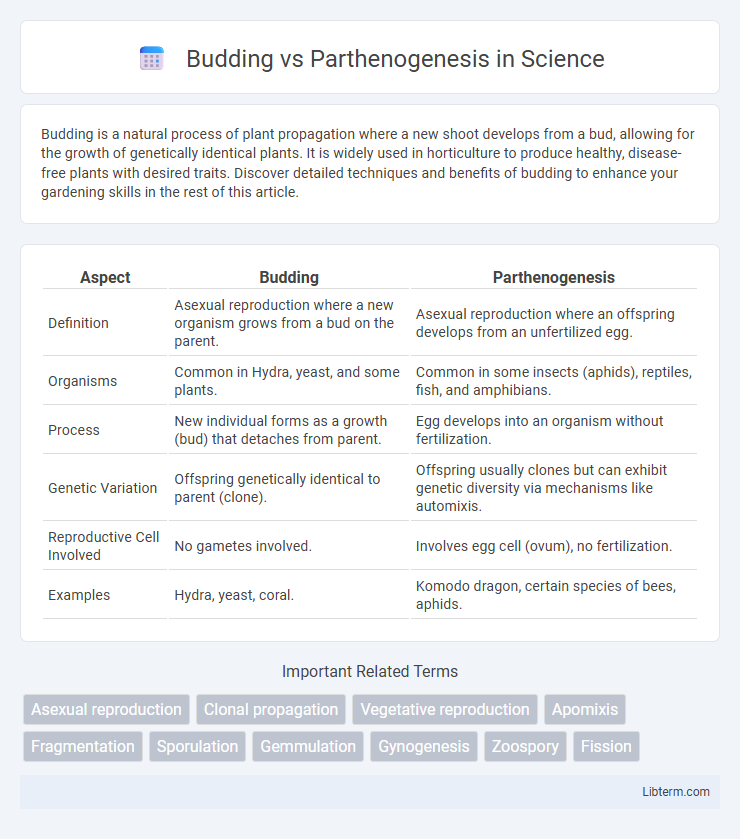Budding is a natural process of plant propagation where a new shoot develops from a bud, allowing for the growth of genetically identical plants. It is widely used in horticulture to produce healthy, disease-free plants with desired traits. Discover detailed techniques and benefits of budding to enhance your gardening skills in the rest of this article.
Table of Comparison
| Aspect | Budding | Parthenogenesis |
|---|---|---|
| Definition | Asexual reproduction where a new organism grows from a bud on the parent. | Asexual reproduction where an offspring develops from an unfertilized egg. |
| Organisms | Common in Hydra, yeast, and some plants. | Common in some insects (aphids), reptiles, fish, and amphibians. |
| Process | New individual forms as a growth (bud) that detaches from parent. | Egg develops into an organism without fertilization. |
| Genetic Variation | Offspring genetically identical to parent (clone). | Offspring usually clones but can exhibit genetic diversity via mechanisms like automixis. |
| Reproductive Cell Involved | No gametes involved. | Involves egg cell (ovum), no fertilization. |
| Examples | Hydra, yeast, coral. | Komodo dragon, certain species of bees, aphids. |
Introduction to Asexual Reproduction
Asexual reproduction involves a single organism producing offspring without genetic contribution from another individual, ensuring rapid population growth and genetic consistency. Budding is a form of asexual reproduction where a new organism develops from an outgrowth or bud on the parent, commonly observed in hydras and yeasts. Parthenogenesis refers to development of an embryo from an unfertilized egg, a process found in certain reptiles, insects, and fish, enabling reproduction without mating.
Definition of Budding
Budding is an asexual reproduction process where a new organism develops from an outgrowth or bud on the parent, eventually detaching to live independently. This method is common in yeasts, hydra, and some plants, allowing for rapid population increase without genetic variation. Parthenogenesis, in contrast, involves the development of offspring from an unfertilized egg, primarily observed in certain insects, reptiles, and fish.
Definition of Parthenogenesis
Parthenogenesis is a form of asexual reproduction in which an egg develops into a complete organism without fertilization by a sperm. This natural process occurs in various invertebrates, such as aphids and some lizards, enabling rapid population growth in favorable environments. Unlike budding, where new individuals form as outgrowths from the parent, parthenogenesis involves development directly from an unfertilized ovum.
Key Differences Between Budding and Parthenogenesis
Budding involves the development of a new organism from an outgrowth or bud on the parent, resulting in genetically identical offspring, while parthenogenesis is a form of asexual reproduction where an egg develops into a new individual without fertilization. Budding occurs mainly in organisms such as hydra and yeast, whereas parthenogenesis is common in some insects, reptiles, and fish. The key difference lies in the mode of offspring formation: budding relies on mitotic growth from the parent body, whereas parthenogenesis involves the direct development of an unfertilized egg.
Biological Mechanisms of Budding
Budding is an asexual reproductive mechanism where a new organism develops from an outgrowth or bud due to cell division at a specific site, commonly observed in yeast and hydra. This process involves mitotic cell division that produces a genetically identical clone without the need for gamete fusion, with the bud eventually detaching to become an independent organism. In contrast, parthenogenesis results from the development of an embryo from an unfertilized egg, mainly occurring in certain invertebrates and vertebrates, involving cellular mechanisms distinct from the localized tissue growth seen in budding.
Biological Mechanisms of Parthenogenesis
Parthenogenesis is a form of asexual reproduction where an egg develops into an organism without fertilization, involving mechanisms such as automixis and apomixis that restore diploidy through processes like meiosis or mitosis. In automictic parthenogenesis, the egg undergoes meiosis but diploidy is re-established by fusion of haploid nuclei, while apomictic parthenogenesis bypasses meiosis entirely, producing offspring genetically identical to the parent. Budding, by contrast, involves the outgrowth of a new individual from a parent organism's body, lacking the cellular process of egg development characteristic of parthenogenetic reproduction.
Examples of Organisms Exhibiting Budding
Hydra and yeast are prime examples of organisms exhibiting budding, where a new individual develops from an outgrowth of the parent organism. In Hydra, budding results in genetically identical polyps forming directly on the parent's body, eventually detaching to live independently. Similarly, Saccharomyces cerevisiae, commonly known as baker's yeast, produces buds that grow and separate to form new yeast cells, highlighting a common asexual reproduction strategy in unicellular fungi.
Examples of Organisms Exhibiting Parthenogenesis
Parthenogenesis is observed in various organisms such as aphids, where females produce offspring without fertilization, and in certain species of lizards like the whiptail lizard, which reproduce solely through this asexual process. Honeybees also demonstrate parthenogenesis, with unfertilized eggs developing into male drones. These examples highlight the diversity of parthenogenetic reproduction across invertebrates and vertebrates, contrasting with budding, which is primarily seen in organisms like hydras and yeast.
Evolutionary Advantages and Disadvantages
Budding allows for rapid population growth with minimal energy expenditure, fostering genetic stability but limiting diversity, which can hinder adaptation to changing environments. Parthenogenesis enables reproduction without a mate, ensuring survival in isolated or low-density populations, yet leads to reduced genetic variation, increasing vulnerability to diseases and environmental shifts. Both methods offer evolutionary advantages in specific contexts but pose disadvantages in terms of long-term species adaptability and resilience.
Applications and Implications in Science
Budding and parthenogenesis serve as crucial models in developmental biology and regenerative medicine due to their unique reproductive mechanisms that bypass sexual reproduction. Budding facilitates insights into cellular differentiation and tissue regeneration, impacting stem cell research and organ development studies, while parthenogenesis offers potential in cloning and genetic conservation by enabling embryo development without fertilization. These processes have significant implications for biotechnology, agriculture, and medicine, promoting advancements in genetic engineering, species preservation, and therapeutic cloning techniques.
Budding Infographic

 libterm.com
libterm.com